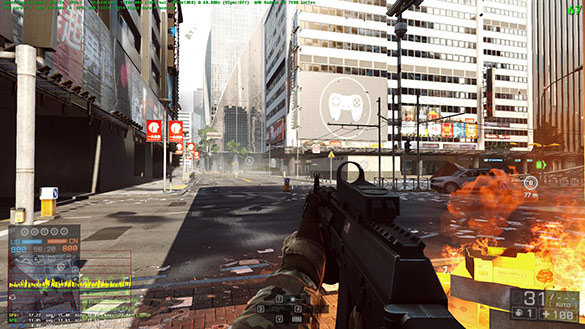AMD Mantle vs. DirectX Benchmarks with Battlefield 4 and Star Swarm
As we mentioned a few days back, AMD’s been working on a new set of drivers for its GCN-based graphics cards and APUs, which enable Mantle and a number of other features as well.
Just to quickly recap, the Catalyst 14.1 betas (which were just released and are available here) are the first publicly available drivers from AMD that support Mantle, AMD’s “close to the metal” API that’ll let developers wring additional performance from systems equipped with GCN-based GPUs. The new drivers, however, will also add support for the HSA-related features introduced with the recently released Kaveri APU, and will reportedly fix the frame pacing issues associated with Radeon HD 7000 series CrossFire configurations as well, at resolutions above 1600p. AMD introduced frame pacing into their graphics drivers a few months ago, but resolutions above 2560x1600 were not supported, which meant Eyefinity or 4K monitor owners were out of luck. In addition, the Catalyst 14.1 beta drivers will reportedly fix frame pacing issues with dual-graphics (APU + Discrete) configurations too.
We had a chance to play around with the Catalyst 14.1 beta drivers on a couple of different system configurations to see how using Mantle affected performance. We tested two applications, the popular game Battlefield 4 and a new benchmark called Star Swarm, which leverages the Nitrous 3D engine. You can read more about Star Swarm and see a video of it in action here.
We tested the Catalyst 14.1’s with Mantle on an AMD A10-7850K Kaveri APU-based system, with and without discrete graphics, and with a Core i3-4330-based system equipped with a Radeon R9 290X discrete GPU. Both systems were outfitted with 8GB of DDR3-2133 system memory and were running Windows 8.1. We chose to test on these particular configurations because Mantle will show the greatest benefit in CPU bound workloads. There are some efficiencies on the GPU side as well, which will increase performance in GPU bound workloads too, but the greatest gains will be realized when Mantle can minimize the CPU overhead associated with DirectX, freeing up the CPU to process more data and keep the GPU fed. AMD has an excellent explanation as to how and why Mantle affects performance in this blog post.

As you can see in this first batch of numbers from Battlefield 4, Mantle has a significant impact on performance. On the GPU-bound A10-7850K, when tested with its on-processor Radeon R7 graphics, BF4’s performance increased roughly 10%. Pop in a powerful discrete GPU, however, and the gains are much larger. When the A10-7850K was paired to a Radeon R9 290X, utilizing Mantle resulted in a 28% increase in performance over DirectX. Performing the same test with that Radeon R9 290X installed in the Core i3-4330-based system showed Mantle outperforming DirectX by about 13%.


In the Star Swarm benchmark, the performance differences between DirectX and Mantle are much more dramatic. When testing Star Swarm with its built-in RTS demo on the Core i3 + R9 290X system, Mantle outperformed DirectX by margins of 181% (low quality), 168% (medium quality), and 106% (extreme quality).
The A10-7850K-powered system showed similar sized performance gains with Mantle. On the A10-7850K system, Mantle outpaced DirectX in Star Swarm’s RTS demo by margins of 78% (low quality), 92% (medium quality), and 70% (high quality). The Star Swarm demo is a little too much for the A10-7850K’s integrated Radeon R7-class GPU, but at the low quality setting, using Mantle at least makes the animation into playable framerate territory.
Mantle is still in its very early stages and Battlefield 4 and Star Swarm are the only applications currently available that leverage the technology. In time though, we should see more games that use Mantle and we suspect AMD will be able to further optimize its software to improve performance even more. Time will tell if Mantle makes a significant impact on PC gaming, but based on these limited tests, it’s clear that the low-overhead associated with the API can result in some monster performance gains in the right situations.
What’s also clear is that Microsoft hasn’t done enough to optimize graphics performance on the PC. DirectX has evolved greatly over the years and has enabled developers to create some fantastic looking games. But with overheard so high, there’s too much performance being sacrificed, likely for no good reason. Hopefully, at the very least, Mantle convinces Microsoft to do some tuning to DirectX to push the PC platform even further ahead of everything else out there.



